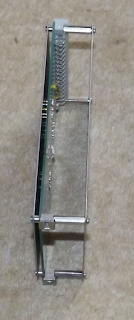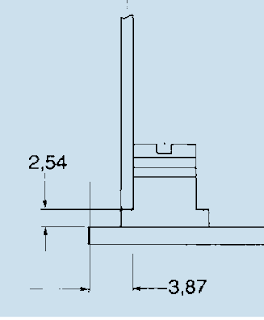ruffrecords
Well-known member
A few months ago I bought some EELA consoles with a view to turning them into tube consoles. The main channel strip in these is 40mm wide and 375mm long. It is made from a single piece of U shaped steel which gives it the necessary strength over the 375mm unsupported span. I don't have the money to have a custom steel U shape made for my own strips so I am looking at alternative more flexible schemes. And I am wondering if the basic scheme I now use for my Mark 3 tube modules micgh still work over this span. It works like this:
The front panel is 2mm aluminium and is mostly cosmetic. The PCB would run all along the left edge of the front panel, connected to it at intervals by a standard die casting. Along the right edge would run a steel sheet basically the same size as the PCB and also attached to the front panel by die castings. The modules would be about 75mm deep so both the PCB and the steel sheet would be this deep. Together with the front panel they form a 75 by 40 by 75 U shape. In the Mark 3 I turn this into a rigid box by tying the back of the PCB and steel sheet together using metal pillars placed on the same spacing as the die casings. Here is a pic of how this works in a normal (short) modules:

It works fine over the 128mm length of my normal modules if I space the supporting pillars and die castings at this sort of interval I am hoping it will be as strong. My only other concern is that the front panel extends about 5mm at the top and bottom in order to attach the modules to the frame. This 5mm of aluminium top and bottom easily supports a 128mm high module but will it be OK for 375mm?? Most of the weight of the module would be in the steel supporting sheet.
Looking for a sanity check please.
Cheers
Ian
The front panel is 2mm aluminium and is mostly cosmetic. The PCB would run all along the left edge of the front panel, connected to it at intervals by a standard die casting. Along the right edge would run a steel sheet basically the same size as the PCB and also attached to the front panel by die castings. The modules would be about 75mm deep so both the PCB and the steel sheet would be this deep. Together with the front panel they form a 75 by 40 by 75 U shape. In the Mark 3 I turn this into a rigid box by tying the back of the PCB and steel sheet together using metal pillars placed on the same spacing as the die casings. Here is a pic of how this works in a normal (short) modules:

It works fine over the 128mm length of my normal modules if I space the supporting pillars and die castings at this sort of interval I am hoping it will be as strong. My only other concern is that the front panel extends about 5mm at the top and bottom in order to attach the modules to the frame. This 5mm of aluminium top and bottom easily supports a 128mm high module but will it be OK for 375mm?? Most of the weight of the module would be in the steel supporting sheet.
Looking for a sanity check please.
Cheers
Ian








